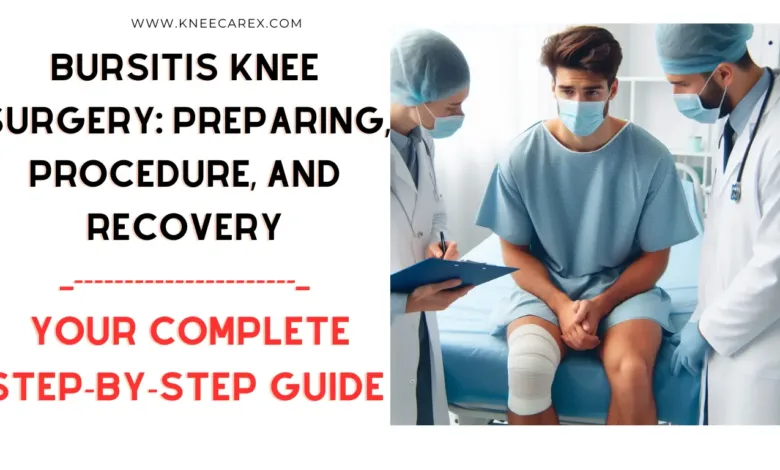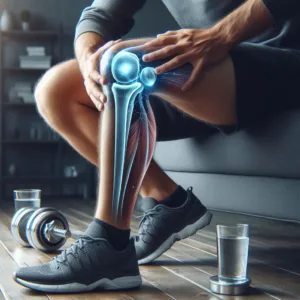Bursitis Knee Surgery: Preparing, Procedure, and Recovery

Knee bursitis is a debilitating condition that affects daily activities and mobility. However, there is hope with Bursitis Knee Surgery. This article explores the procedure and recovery process for this innovative surgery, offering insights into its potential to provide relief and improve quality of life. Advances in medical technology and surgical techniques have made it possible for individuals suffering from this condition to have a viable solution for long-term relief. Understanding effective knee surgery for bursitis is essential for those considering treatment options or seeking to broaden their knowledge on this topic.
Contents
Understanding Knee Bursitis

Furthermore, it’s essential to understand that while rest and ice can help alleviate symptoms in the short term, addressing the underlying cause of knee bursitis is crucial for long-term relief. This may involve physical therapy to strengthen the muscles supporting the knee joint or modifying activities that aggravate the bursae. By taking a holistic approach to understanding knee bursitis and its treatment options, individuals can gain a clearer perspective on how best to manage this often debilitating condition.
The Need for Surgery: When is it Necessary?
Surgery is often a daunting prospect, evoking fear and uncertainty in many patients. However, there are certain circumstances where surgery becomes necessary for effective treatment. In the case of severe bursitis in the knee, conservative treatments may not provide adequate relief, warranting surgical intervention. When daily activities become significantly impaired by persistent pain and restricted movement, surgery can offer a viable solution to restore mobility and alleviate symptoms. Patients need to understand that surgery should be considered a last resort after exhausting non-invasive measures. Still, when it becomes necessary, it can be transformative in restoring quality of life.
Considering surgery for bursitis may feel overwhelming, but ongoing discomfort and limited functionality can take a toll on one’s overall well-being. Surgical intervention offers an opportunity to address the root cause of the problem and achieve long-term relief from chronic pain. Additionally, advancements in surgical techniques have led to minimally invasive procedures with reduced recovery times and improved outcomes. By embracing the possibility of surgery as a strategic step toward regaining optimal joint health and functionality, individuals can look forward to effectively managing their condition and returning to an active lifestyle.
Is Walking Good For Knee Bursitis Treatment| Expert Guide 2024
Preparing for the Knee Surgery

Mentally, preparing for knee surgery involves managing expectations and understanding that it’s a journey toward healing rather than an instant fix. This may include seeking emotional support from loved ones or joining support groups related to knee surgeries. Additionally, taking time for self-care activities such as meditation or engaging in hobbies you enjoy can help ease pre-surgery anxiety. Being proactive about understanding the procedure itself by discussing any concerns or questions with your surgeon can also alleviate fear and uncertainty leading up to the operation. By approaching knee surgery with a well-rounded preparation strategy encompassing physical readiness, mental fortitude, and emotional support systems, you’ll set yourself up for a smoother recovery journey.
Understanding the Surgical Procedure
The surgical procedure for knee surgery to address bursitis can seem daunting, but understanding the process is crucial for a successful recovery. The surgeon will begin by making an incision to access the affected area and remove the inflamed bursa. This is followed by smoothing down any rough surfaces on the bones surrounding the knee joint to prevent further irritation. Additionally, any damaged tissue may be repaired or removed during the procedure to ensure optimal healing.
It’s important to grasp that while surgery is a significant step in treating knee bursitis, it’s just one part of the overall recovery process. Post-surgery rehabilitation and physical therapy are equally vital for restoring strength and mobility in the knee. Patients should be prepared for an extended period of rest and the gradual reintroduction of activities as part of their recovery journey. Understanding these essential aspects can help individuals approach their surgical experience with confidence and optimism for a successful outcome.
Post-Surgery Care: Recovery Process and Tips

In order to optimize the recovery process, it’s imperative to maintain a healthy lifestyle that supports overall well-being while allowing the body to heal. This may involve incorporating nutritious foods into your diet to promote healing and boost energy levels. Furthermore, practicing good posture, using assistive devices when needed, and gradually increasing physical activity can aid in regaining strength and flexibility in the affected knee. Taking proactive steps such as managing stress levels through relaxation techniques or seeking emotional support from loved ones can also contribute to an all-encompassing approach towards post-surgery care and recovery.
Physical Therapy and Rehabilitation Exercises
Physical therapy and rehabilitation exercises play a crucial role in the recovery process following knee surgery for bursitis. These exercises are designed to improve strength, flexibility, and range of motion in the affected knee, helping patients regain mobility and function. Physical therapists use a variety of techniques, such as joint mobilization, manual therapy, and targeted exercises, to address specific muscle imbalances and restore proper biomechanics. By incorporating these rehabilitation exercises into post-operative care, patients can reduce pain, swelling, and stiffness while promoting healing and preventing future injury.
Moreover, physical therapy not only focuses on the knee itself but also addresses overall body mechanics and posture to ensure long-term success. Through a comprehensive rehabilitation program tailored to individual needs, patients can expect improved balance, stability, and coordination. The incorporation of functional movement patterns into exercise routines helps individuals relearn how to perform daily activities with ease while reducing the risk of re-injury. Ultimately, physical therapy empowers patients to take an active role in their recovery process by building strength and resilience through targeted exercise programs that lay the foundation for long-term joint health.
FAQ’s
How long does it take to recover from knee bursitis surgery?
Recovery time from knee bursitis surgery varies, typically ranging from a few weeks to several months. The duration depends on the surgery’s extent, the patient’s overall health, and adherence to post-operative care. Physical therapy plays a crucial role in recovery, aiding in regaining strength and mobility. Consistent follow-up and adherence to a rehabilitation program can expedite the recovery process.
Can you walk after a knee bursectomy?
Walking after a knee bursectomy is generally possible, but it depends on the individual case and the surgeon’s advice. Initially, patients may need assistance or support, like crutches or a walker. Gradual weight-bearing is often encouraged as part of the recovery process. It’s crucial to follow the specific guidance given by the healthcare provider for safe and effective rehabilitation.
Is a bursectomy a major surgery?
A bursectomy, the surgical removal of a bursa, is generally considered a minor procedure, especially when compared to more extensive orthopedic surgeries. It’s often performed arthroscopically, which is less invasive, leading to quicker recovery times and reduced risk of complications. However, as with any surgery, the individual’s condition and overall health can influence the procedure’s complexity and recovery.
Is draining knee bursitis painful?
Draining knee bursitis, typically done through needle aspiration, can cause discomfort or mild pain. The level of pain varies depending on the individual’s pain tolerance and the inflammation severity. Local anesthesia is often used to minimize discomfort during the procedure. Post-procedure, there may be some soreness or discomfort at the aspiration site, which usually subsides relatively quickly.
Conclusion: Bursitis Knee Surgery
In conclusion, effective knee surgery for bursitis can provide significant relief and improve the quality of life for those suffering from this condition. By addressing the underlying issues causing pain and inflammation, the procedure offers a promising solution for patients who have not found relief through other treatments. Additionally, understanding the recovery process and following post-operative care instructions are crucial for achieving successful outcomes. With advancements in surgical techniques and rehabilitation protocols, there is hope for a smoother recovery and a quicker return to normal activities. If you or someone you know is considering knee surgery for bursitis, consult with a qualified orthopedic surgeon to explore the best options available and take proactive steps toward regaining mobility and comfort.




